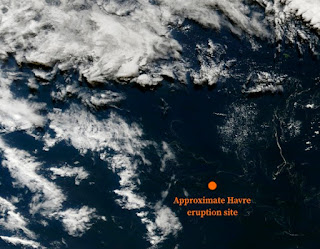Volcano Research Supports Creation Science Flood Models
The Genesis Flood is extremely important in creation science, and there are Flood models postulated to correspond with observational evidence. Of course, biblical creationists disagree on details and put forward differing models, but agree that the Word of God is of primary importance.
People tend to have a superficial knowledge of the Flood, thinking it was only 40 days and nights. No, the waters were on the earth for 150 days. There was much more happening than rain, and creationists are interested in paleontology, geology, and volcanism.
 |
| Havre Volcano, original image: NASA / Jeff Schmaltz LANCE / EOSDIS MODIS Rapid Response Team, GSFC (usage does not imply endorsement) |
Researchers learned that there were eighty-five global eruptions, most of which were larger than any in recorded history. This easily fits creation science models, and the resulting warmer oceans would be one of the most important parts to cause the Ice Age — something that uniformitarian geologists cannot adequately explain.
Evidence continues to accumulate that the Genesis Flood caused an ice age lasting hundreds of years.
Creation scientists maintain there are two significant climate factors needed for an ice age. First, warm oceans are needed to increase evaporation, which ultimately generates extra rain near the equator and heavy snowfall in higher latitudes. Such conditions would build ice sheets atop the continents. Second, Earth’s atmosphere must contain enough very small airborne particles and droplets called aerosols to reflect sunlight and keep the ice from melting during warm summer months. These aerosols would be provided by explosive volcanic eruptions, which are known to be capable of causing cooler summers.
Reading the rest of this article should keep you busy for about five minutes. To do so, visit "Intense Ice Age Volcanism Fits Biblical Model." After that, come back for the other section!
Theories and models about what happened in the past (forensic science), like any models in science, should be explanatory. If the Genesis Flood really happened, there are certain things in geology that would support it (carefully avoiding confirmation bias, of course). Secular geologists mostly ignored the underwater eruption of Havre, since they presupposed that it was unlikely to have noticeable effects. They were wrong. It was finally studied, and not only was it powerful, but ties in with Flood models.
A team of scientists from Australia and the USA recently studied the ejecta from a subsea volcano, gaining new insights into how magma can explode to the surface from deep underwater. This discovery also gives important insight into volcanic activity during the Flood year when many volcanoes originated while still underwater.
. . .
The team, publishing in Communications Earth & Environment, found that the minerals in the ejecta suggest a “short-lived but powerful explosive eruption phase penetrated the water column [3000 feet] allowing hot pyroclasts to oxidise in air.”
This is another five-minute article. To read it all, blast over to "Deep-Sea Volcano Gives Glimpse of Flood Eruptions."